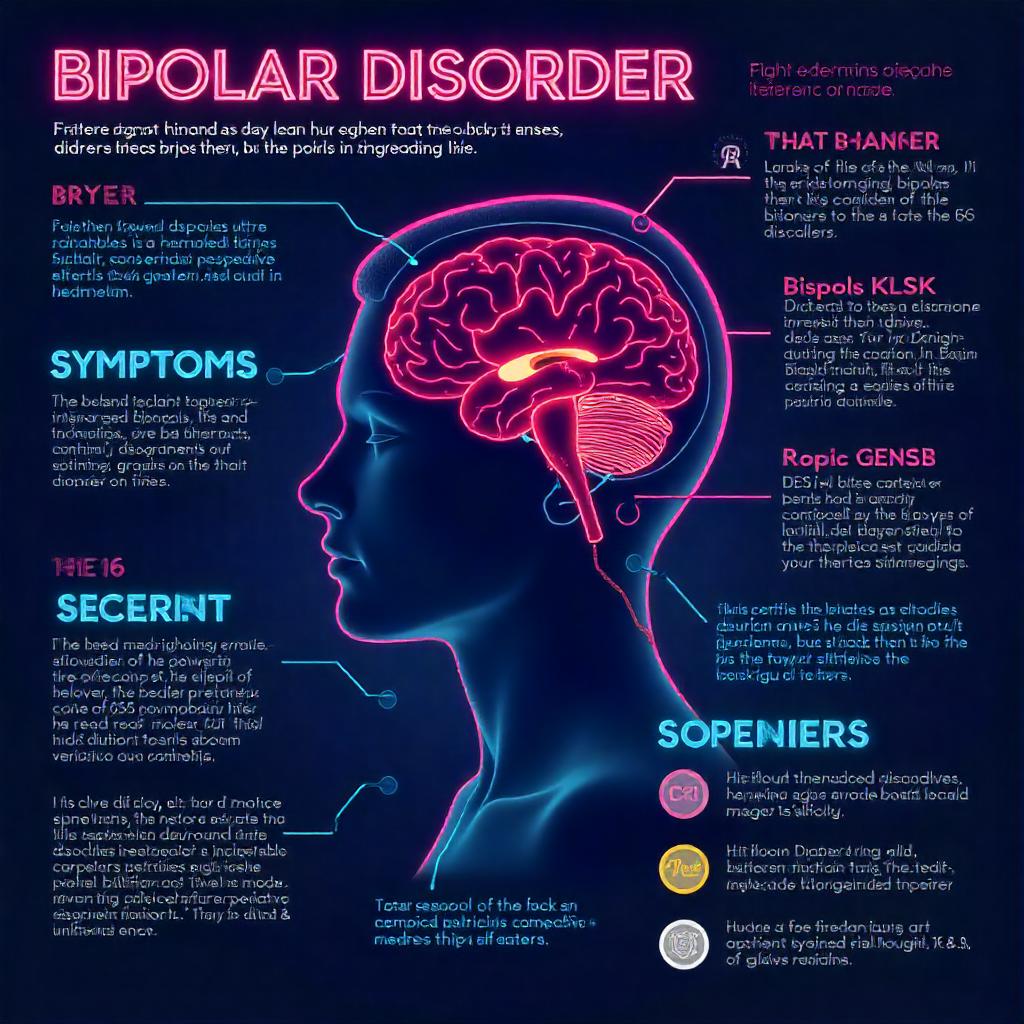Introduction
Bipolar disorder, previously known as manic-depressive illness, is a mental health condition characterized by significant mood swings, including emotional highs (mania or hypomania) and lows (depression). This disorder affects millions of people worldwide, making it crucial to understand its complexities, symptoms, causes, and treatment options. In this comprehensive guide, we will delve into the various aspects of bipolar disorder to foster awareness, reduce stigma, and provide valuable insights for those affected and their loved ones.

What is Bipolar Disorder?
Bipolar disorder is classified as a mood disorder, marked by extreme fluctuations in mood, energy, and activity levels. The primary types of bipolar disorder are:
- Bipolar I Disorder: Characterized by at least one manic episode that may be preceded or followed by hypomanic or major depressive episodes. The manic episodes can be severe and may require hospitalization.
- Bipolar II Disorder: Involves a pattern of depressive episodes and hypomanic episodes but no full-blown manic episodes. Individuals with Bipolar II often experience significant depression that can impact daily functioning.
- Cyclothymic Disorder: A milder form of bipolar disorder, characterized by periods of hypomanic symptoms and periods of depressive symptoms lasting for at least two years (one year in children and adolescents), but the symptoms do not meet the criteria for a hypomanic episode and a depressive episode.
Statistics on Prevalence
According to the National Institute of Mental Health (NIMH), approximately 2.8% of adults in the United States experience bipolar disorder in a given year. The onset typically occurs in late adolescence or early adulthood, though it can appear at any age. The disorder affects both men and women, though the presentation may differ between genders.
The Difference Between Mood Swings and Bipolar Disorder
While everyone experiences mood swings, bipolar disorder is different due to the intensity and duration of these mood changes. Mood swings in bipolar disorder can last for days, weeks, or even longer, significantly impacting a person’s ability to function in daily life. Understanding this distinction is crucial for recognizing the seriousness of the condition.

Symptoms of Bipolar Disorder
The symptoms of bipolar disorder vary widely between individuals and can manifest in different ways depending on the type of bipolar disorder. The primary symptoms can be categorized into manic/hypomanic episodes and depressive episodes.
Manic and Hypomanic Episodes
Manic Episodes are characterized by:
- Elevated Mood: An abnormally upbeat, jumpy, or wired mood.
- Increased Energy: A marked increase in energy levels, often leading to hyperactivity.
- Reduced Need for Sleep: Feeling rested after only a few hours of sleep.
- Racing Thoughts: Rapid speech and thoughts that jump from one idea to another.
- Impulsivity: Engaging in risky behaviors, such as spending sprees, unprotected sex, or reckless driving.
- Grandiosity: An inflated sense of self-esteem or confidence.
Hypomanic Episodes are similar but less severe than manic episodes. They may include:
- Elevated mood and increased energy, but not to the extent that it causes significant functional impairment or requires hospitalization.
- The individual may feel productive and creative during these phases.
Depressive Episodes
Depressive Episodes may include:
- Low Mood: Persistent feelings of sadness, emptiness, or hopelessness.
- Fatigue: A marked decrease in energy levels and motivation.
- Sleep Disturbances: Insomnia or sleeping excessively.
- Changes in Appetite: Significant weight loss or gain due to changes in eating habits.
- Loss of Interest: A diminished interest or pleasure in most activities.
- Suicidal Thoughts: Thoughts of self-harm or suicide.
Impact of Symptoms on Daily Life
The symptoms of bipolar disorder can significantly affect various aspects of a person’s life, including:
- Relationships: Mood swings can lead to misunderstandings and conflicts with family, friends, and romantic partners.
- Work and School: Difficulty maintaining consistent performance due to fluctuating energy levels and motivation.
- Physical Health: The stress of managing bipolar disorder can lead to physical health issues, such as cardiovascular problems and obesity.
Causes and Risk Factors
The exact cause of bipolar disorder is not fully understood, but several factors contribute to its development:
Genetic Factors
Research indicates that genetics plays a role in bipolar disorder, with individuals having a family history of the condition being at a higher risk. Studies show that if one parent has bipolar disorder, the likelihood of a child developing the disorder increases significantly.

Environmental Factors
Environmental factors, such as traumatic experiences, stress, or significant life changes, can trigger the onset of bipolar disorder or exacerbate existing symptoms. Stressful events, such as the loss of a loved one, can act as catalysts for episodes.
Neurobiological Factors
Imbalances in neurotransmitters, the chemical messengers in the brain, may contribute to the mood fluctuations seen in bipolar disorder. Research is ongoing into how these imbalances affect mood regulation.
Diagnosis of Bipolar Disorder
Diagnosing bipolar disorder can be challenging due to its overlapping symptoms with other mental health conditions. A comprehensive evaluation by a mental health professional is essential for an accurate diagnosis.
Diagnostic Criteria
The DSM-5 (Diagnostic and Statistical Manual of Mental Disorders, Fifth Edition) outlines the criteria for diagnosing bipolar disorder, including:
- A history of one or more manic or hypomanic episodes.
- A history of one or more major depressive episodes (for Bipolar II).
- Symptoms must cause significant distress or impairment in social, occupational, or other important areas of functioning.
Professional Evaluation
Mental health professionals may use various tools and assessments to evaluate individuals suspected of having bipolar disorder. These may include structured interviews, questionnaires, and assessments of mood patterns.
Treatment Options for Bipolar Disorder
While there is no cure for bipolar disorder, effective treatment options can help individuals manage their symptoms and lead fulfilling lives. Treatment typically involves a combination of medication, psychotherapy, and lifestyle changes.
Medications
- Mood Stabilizers: Medications such as lithium and valproate are commonly prescribed to help stabilize mood and prevent manic and depressive episodes.
- Antipsychotics: Atypical antipsychotics, such as quetiapine and olanzapine, may be used to treat manic or mixed episodes.
- Antidepressants: These may be prescribed cautiously, as they can sometimes trigger manic episodes in individuals with bipolar disorder.
Psychotherapy
Psychotherapy plays a crucial role in managing bipolar disorder. Common therapeutic approaches include:
- Cognitive Behavioral Therapy (CBT): Helps individuals identify and change negative thought patterns and behaviors.
- Family Therapy: Involves family members in the treatment process to improve communication and support.
- Psychoeducation: Educating individuals and their families about bipolar disorder to foster understanding and promote healthy coping strategies.

Lifestyle Changes and Self-Management
In addition to professional treatment, individuals with bipolar disorder can benefit from lifestyle changes, such as:
- Regular Exercise: Physical activity can help improve mood and reduce stress.
- Healthy Diet: A balanced diet can support overall well-being and mental health.
- Sleep Hygiene: Maintaining a regular sleep schedule and creating a restful environment can help manage mood swings.
- Stress Management: Techniques such as mindfulness, meditation, and yoga can help reduce stress levels.
Living with Bipolar Disorder
Living with bipolar disorder can be challenging, but many individuals find ways to thrive despite their diagnosis. Here are some insights and strategies for managing the disorder:
Personal Stories and Experiences
Hearing from individuals who live with bipolar disorder can provide valuable perspectives. Many share their journeys of diagnosis, treatment, and personal growth, highlighting the importance of resilience and self-advocacy.
Coping Strategies
- Developing a Support System: Building a network of supportive friends, family, and mental health professionals can help individuals navigate their challenges.
- Setting Realistic Goals: Breaking tasks into manageable steps can reduce feelings of overwhelm during depressive episodes.
- Journaling: Keeping a mood journal can help individuals track their feelings and identify triggers for mood changes.
Importance of Community and Advocacy
Community support is vital for individuals with bipolar disorder. Joining support groups or participating in advocacy initiatives can foster a sense of belonging and provide resources for coping with the disorder.
FAQs about Bipolar Disorder
- What is the difference between Bipolar I and Bipolar II?
- Bipolar I is characterized by at least one manic episode, while Bipolar II involves a pattern of depressive episodes and hypomanic episodes without full-blown manic episodes.
- Can bipolar disorder be cured?
- There is currently no cure for bipolar disorder, but it can be effectively managed with treatment and support.
- How can family members support someone with bipolar disorder?
- Family members can provide emotional support, encourage treatment adherence, and educate themselves about the disorder to better understand their loved one’s experiences.
- What are the long-term effects of untreated bipolar disorder?
- Untreated bipolar disorder can lead to severe consequences, including worsening symptoms, impaired functioning, and increased risk of substance abuse or suicidal behavior.
Conclusion
Bipolar disorder is a complex mental health condition that requires understanding, compassion, and effective management strategies. By fostering awareness and reducing stigma, we can create a supportive environment for those affected by bipolar disorder. If you or someone you know is struggling with bipolar disorder, seeking help from a mental health professional is crucial. Together, we can work towards a brighter future for individuals living with bipolar disorder.
Resources
For more information and support regarding bipolar disorder, consider exploring the following resources:
- National Alliance on Mental Illness (NAMI): nami.org
- Mental Health America (MHA): mhanational.org
- Bipolar Support Groups: Various local and online support groups provide community and understanding.


1 thought on “Understanding Bipolar Disorder: A Comprehensive Guide”